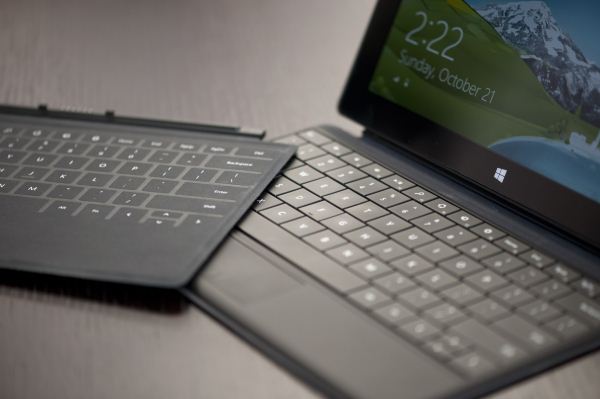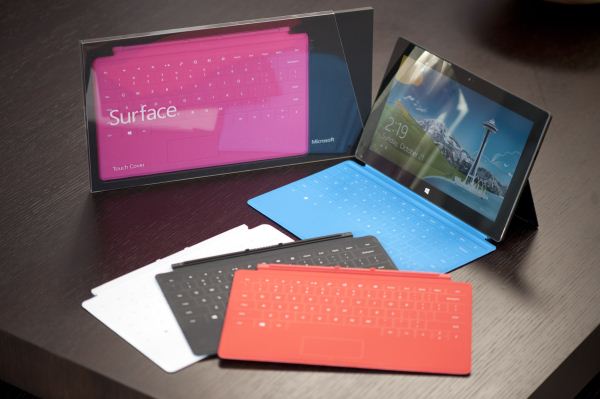Microsoft Surface Review
by Anand Lal Shimpi on October 23, 2012 9:01 PM EST- Posted in
- Tablets
- Microsoft
- Mobile
- Surface
- Windows RT
Pricing and Final Words
Last week Microsoft announced pricing for Surface. The base configuration starts at $499 with 32GB of internal storage, you can get a bundle with a black Touch Cover for $599 and finally there’s a 64GB model with Touch Cover for $699. All versions of Surface come with Office 2013 Home & Student Edition preview, and will be upgraded (for free) to the final build of Office 2013 once it’s available.
Whether or not Surface is priced appropriately really depends on how much you value Windows RT and getting Office 2013 for free. I suspect if you’re already a big Office user, you’ll see a lot of value in the bundle. On the Windows RT side, whether or not that platform has value really depends on how frustrated you are by the multitasking, task switching and lack of screen sharing (two apps on the screen at once) of other mobile OSes. Depending on your feelings on those two issues Surface will either feel like a bargain, or too much.
As a device, Surface is incredibly well executed. It makes sense that Microsoft’s OEM partners are feeling the pressure as there’s very little that I would change about Surface from a design perspective. The chassis is well built and the integrated kickstand is seriously one of the most useful features to ever meet a tablet. The optional Touch and Type Covers complete the package. While a full sized notebook is going to deliver a better typing experience, when paired with its Touch/Type covers Surface results in a more productive platform than any other tablet.
Surface is the most flexible tablet I've ever used. Through two seemingly simple additions to the design (but incredibly complex to actually develop and implement), Microsoft took a tablet and turned it into something much more. If you're frustrated by productivity limits of currently available tablets, Surface really seems to be the right formula for a solution. It's important to note that Microsoft's execution with Surface establishes the company as a competitive powerhouse in the mobile design market. I can only imagine what multiple revs of the design will give us, not to mention what could happen if Microsoft set its obsessive sights on smartphones or notebooks.
The Windows RT experience, in many senses, is clearly ahead of what many competitors offer in the tablet space today. Multitasking, task switching and the ability to have multiple applications active on the screen at once are all big advantages that Microsoft enjoys. For productivity workloads, Surface is without equal in the tablet space.
Content consumption is also great on the device. Surface's display isn't industry leading but it's still good. Reading emails, browsing the web flipping through photos and watching videos are all good fits for the platform - just as good as competing solutions from Apple or Google.
More impressive than the fact that Microsoft brought competitive parity to the Windows tablet usage model is the fact that power efficiency doesn't seem to be an issue for Windows RT. Microsoft has built a mobile OS that is capable of, at least based on what we've seen today with Surface, being competitive with Android and iOS solutions when it comes to battery life. With lower power silicon inside, Microsoft could do even better.
I don't believe Surface is perfect, but it's a platform I can believe in. What I'm most excited about is to see what happens after a second or third rev of the design. I would have liked to have seen faster hardware inside (I'd love to see an Atom based version). There are also some rough edges that could use smoothing out (e.g. the power connector and HDMI output come to mind) and Windows RT likely needs another round of updates (app launch times are far too long, more apps needed) but overall the device is easily in recommendable territory. The biggest issue I have with recommending Surface today is that you know the next iteration of the device is likely going to be appreciably better, with faster/more efficient hardware and perhaps even a better chassis.
If you're ok being an early adopter, and ok dealing with the fact that mobile devices are still being significantly revved every year, Surface is worth your consideration. If you've wanted a tablet that could begin to bridge the content consumption and productivity divide, Surface is it.












235 Comments
View All Comments
WP7Mango - Thursday, October 25, 2012 - link
No. That's what the Surface Pro is for.tzhu07 - Thursday, October 25, 2012 - link
If I were to buy a tablet today, I'll still take the iPad for the most widespread support.kyuu - Thursday, October 25, 2012 - link
So what's up with the Windows RT review? Really looking forward to it, but it's a day+ late now (at least I thought I saw that it was supposed to be up later the same day of the Surface review). =(kyuu - Thursday, October 25, 2012 - link
So what's up with the Windows RT review? Really looking forward to it, but it's a day+ late now (at least I thought I saw that it was supposed to be up later the same day of the Surface review). =(simbadogg - Thursday, October 25, 2012 - link
I believe on microsofts spec/surface page they said it was a proprietary connection for HDMI / video out. Is this a standard micro HDMI connector? If so what type (C, D?). Just wanting to know if there can actually be other cables used other than the standard microsoft cable.HisDivineOrder - Thursday, October 25, 2012 - link
Windows RT reminds me so much of XP x64. I think that the next full release/update of RT will be a lot better than this one. I think by then it'll become clear that apps launching slowly and overall lethargic performance is part of what Jobs KNEW was an important component of having a slick, awesome device.Your device has to "feel" fast in order for users to think it's fast. It may not be actually fast, but they have to feel like it is. Every review says the same thing. "It's great, it's different, I really like it, I want to love it, but it's so slow..."
It feels slow because the transitions are slow and the design was not built around tricking the user into thinking it's faster than it is. The whole iOS core started around doing this very thing. Tricking the user into thinking slow hardware was fast with clever use of transitions and design.
It seems like MS did not learn this lesson. Hell, it was in the Jobs biography. Perhaps they should read more.
antef - Thursday, October 25, 2012 - link
Anand, you mention having to double-press or long-press to switch apps on other platforms, but that's not the case with Android in general, only with the new Samsung and LG phones. The other manufacturers rightly went with the Google standard of including a dedicated button for app switching, so it's one press to bring up a list with thumbnails and another press to go to the app you want. I don't think MS's implementation is any better than that. This is the issue with most people using Samsung's and LG's poor designs and not realizing Android is better elsewhere. Of course, Windows RT still wins when it comes to side-by-side mode.tipoo - Thursday, October 25, 2012 - link
A few reviews complained about using the stand on a lap or any non-level surface being unsteady, with the touch cover you can flip it back half way and then have the stand resting on THAT rather than your lap. That should be much more stable as it now has a level surface and much more surface area.pblock - Thursday, October 25, 2012 - link
Thank you for a wonderful, comprehensive review. However, at our office, most of the talk is wondering if the Surface will be usable on your lap. Does the stand work on your lap, or is it too awkward? And what about each of the keyboard covers? Most of us who use laptops rarely place them on a table or desk but instead are using them on the couch or in an easy chair.techenthu - Thursday, October 25, 2012 - link
It has a USB port . Can i use a data card with this?I am sure carriers need some installation before use the data card . So i was wondering if surface will allow using the data card